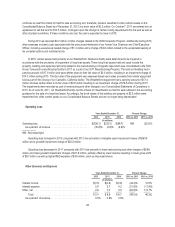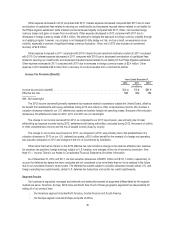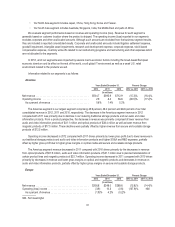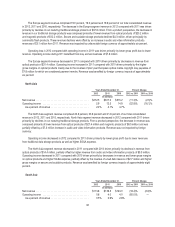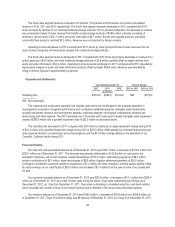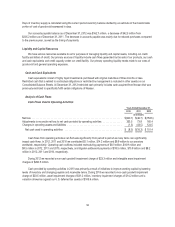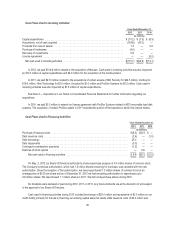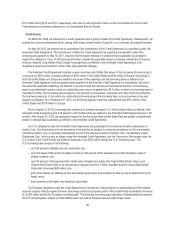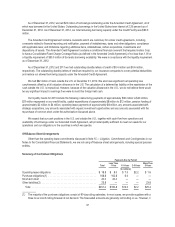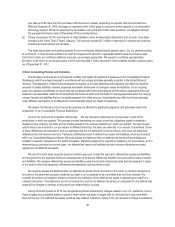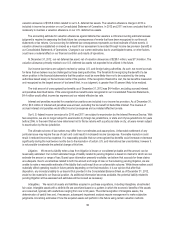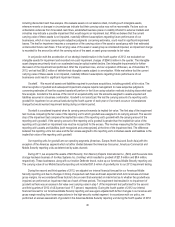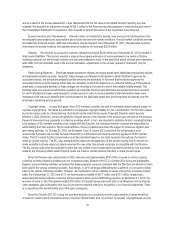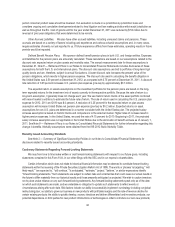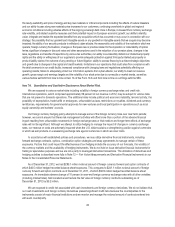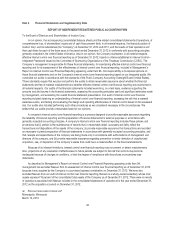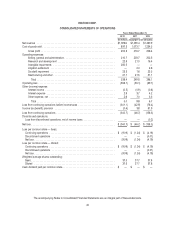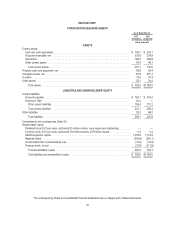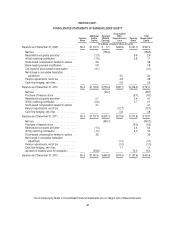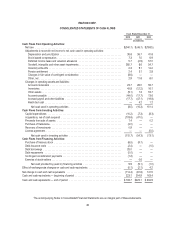Memorex 2012 Annual Report Download - page 42
Download and view the complete annual report
Please find page 42 of the 2012 Memorex annual report below. You can navigate through the pages in the report by either clicking on the pages listed below, or by using the keyword search tool below to find specific information within the annual report.valuation allowance of $105.6 million related to our U.S. deferred tax assets. The valuation allowance charge in 2010 is
included in income tax provision on our Consolidated Statement of Operations. In 2012 and 2011 we have concluded that it is
necessary to maintain a valuation allowance on our U.S. deferred tax assets.
The accounting estimate for valuation allowances against deferred tax assets is a critical accounting estimate because
judgment is required in assessing the likely future tax consequences of events that have been recognized in our financial
statements or tax returns. Our accounting for deferred tax consequences represents our best estimate of future events. A
valuation allowance established or revised as a result of our assessment is recorded through income tax provision (benefit) in
our Consolidated Statements of Operations. Changes in our current estimates due to unanticipated events, or other factors,
could have a material effect on our financial condition and results of operations.
At December 31, 2012, our net deferred tax asset, net of valuation allowances of $239.1 million, was $11.6 million. The
valuation allowance primarily relates to our U.S. deferred tax assets not expected to be utilized in the future.
Our income tax returns are subject to review by various U.S. and foreign taxing authorities. As such, we record accruals
for items that we believe may be challenged by these taxing authorities. The threshold for recognizing the benefit of a tax
return position in the financial statements is that the position must be more-likely-than-not to be sustained by the taxing
authorities based solely on the technical merits of the position. If the recognition threshold is met, the tax benefit is measured
and recognized as the largest amount of tax benefit that, in our judgment, is greater than 50 percent likely to be realized.
The total amount of unrecognized tax benefits as of December 31, 2012 was $4.4 million, excluding accrued interest
and penalties described below. If the unrecognized tax benefits were recognized in our Consolidated Financial Statements,
$4.4 million would affect income tax expense and our related effective tax rate.
Interest and penalties recorded for uncertain tax positions are included in our income tax provision. As of December 31,
2012, $0.3 million of interest and penalties was accrued, excluding the tax benefit of deductible interest. The reversal of
accrued interest and penalties would affect income tax expense and our related effective tax rate.
Our U.S. federal income tax returns for 2010 and 2011 are subject to examination by the Internal Revenue Service. With
few exceptions, we are no longer subject to examination by foreign tax jurisdictions, or state and city tax jurisdictions for years
before 2006. In the event that we have determined not to file tax returns with a particular state or city, all years remain subject
to examination by the tax jurisdiction.
The ultimate outcome of tax matters may differ from our estimates and assumptions. Unfavorable settlement of any
particular issue may require the use of cash and could result in increased income tax expense. Favorable resolution could
result in reduced income tax expense. It is reasonably possible that our unrecognized tax benefits could increase or decrease
significantly during the next twelve months due to the resolution of certain U.S. and international tax uncertainties; however it
is not possible to estimate the potential change at this time.
Litigation. We record a liability when a loss from litigation is known or considered probable and the amount can be
reasonably estimated. Our current estimated range of liability related to pending litigation is based on claims for which we can
estimate the amount or range of loss. Based upon information presently available, we believe that accruals for these claims
are adequate. Due to uncertainties related to both the amount and range of loss on the remaining pending litigation, we are
unable to make a reasonable estimate of the liability that could result from an unfavorable outcome. While these matters could
materially affect operating results in future periods depending on the final resolution, it is our opinion that after final
disposition, any monetary liability to us beyond that provided in the Consolidated Balance Sheet as of December 31, 2012,
would not be material to our financial position. As additional information becomes available, the potential liability related to
pending litigation will be assessed and estimates will be revised as necessary.
Intangibles. We record all assets and liabilities acquired in purchase acquisitions, including intangibles, at estimated
fair value. Intangible assets with a definite life are amortized based on a pattern in which the economic benefits of the assets
are consumed, typically with useful lives ranging from one to 30 years. The initial recognition of intangible assets, the
determination of useful lives and, if necessary, subsequent impairment analysis require management to make subjective
judgments concerning estimates of how the acquired assets will perform in the future using certain valuation methods
39


